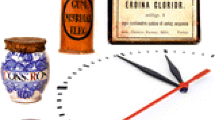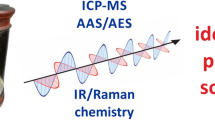Abstract
E.F. Geoffroy's table of different relations (“rapports”) between different chemical substances is mainly based on empirical knowledge accumulated in 16th and 17th century metallurgy and pharmacy. The substances listed in the left half of the table were basic for the formation of salts which were produced for medical ends in the chemical-pharmaceutical practice of the 17th century. The right half of the table refers to substances and operations of metallurgy which had already been described in the metallurgical writings of the 16th century. Even Geoffroy's ordering of the substances within the columns of his table has its origin in metallurgical and pharmaceutical practice. The key concept of the conceptual framework underlying the table and its commentary is the concept of chemical compound which emerged at the end of the 17th century. Geoffroy extends the range of application of this concept, which was first limited to chemical artefacts, to include natural bodies. Eliminating the peripatetical distinction between natural bodies and chemical artefacts he formulates a new research program, consisting in the determination of the “laws” of the relations (“rapports”) between different chemical substances.
Similar content being viewed by others
Literatur
Agricola, Georg (1556):De Re Metailica Libri XII. Basel 1556. Zit. n. der dt. Übers in: Ders.:Ausgewählte Werke. Bd. 8, übers. u. bearb. von G. Fraustadt u.a., Berlin 1974.
Beguin, Jean (1615):Les Elemens de Chymie. Paris 1615 (franz. Ausg. von Ders.:Tyrocinium Chymicum. 1610).
Biringuccio, Vanoccio (1540):De la Pirotechnia (1540). Zit. n. der engl. Ausg.,The Pirotechnia, Transl. with an Introd. and Notes by C.S. Smith and M.T. Gnudi, Cambridge (Mass.) u. London 1959 (Paperback-Ausg. 1966).
Geoffroy, Etienne François (1704): “Maniere de recomposer le Souffre commun par la réunion de ses principes, et d'en composer de nouveau par le mélange de semblables substances, avec quelques conjectures sur la composition des métaux.” In:AdSVeröffentlichungen der Academie Royale des Sciences Paris: (HuM)Histoire de l'Académie Royale des Sciences. Année MDCXCIX [etc.] Avec des Mémoires de Mathématique & de Physique, pour la même Année, Paris 1702–1797. 1704, (M)Mémoires de l'Académie Royale des Sciences depuis 1666 jusqu'à 1699. Bde. 3–10, Paris 1733. 278–286.
Geoffroy, Etienne François (1709): “Experiences sur les Metaux, faites avec ie Verre ardent du Palais Royal.” In:AdSVeröffentlichungen der Academie Royale des Sciences Paris: (HuM)Histoire de l'Académie Royale des Sciences. Année MDCXCIX [etc.] Avec des Mémoires de Mathématique & de Physique, pour la même Année, Paris 1702–1797. 1709, (M)Mémoires de l'Académie Royale des Sciences depuis 1666 jusqu'à 1699. Bde. 3–10, Paris 1733. 162–176.
Geoffroy, Etienne François (1718): “Table des differents rapports observés en Chimie entre differentes substances.” In:AdSVeröffentlichungen der Academie Royale des Sciences Paris: (HuM)Histoire de l'Académie Royale des Sciences. Année MDCXCIX [etc.] Avec des Mémoires de Mathématique & de Physique, pour la même Année, Paris 1702–1797. 1718, (M)Mémoires de l'Académie Royale des Sciences depuis 1666 jusqu'à 1699. Bde. 3–10, Paris 1733. 202–212.
Geoffroy, Etienne François (1720): “Eclaircissements Sur la Table insérée dans les Mémoires de 1718 concernant les Rapports observés entre différentes Substances.” In.AdSVeröffentlichungen der Academie Royale des Sciences Paris: (HuM)Histoire de l'Académie Royale des Sciences. Année MDCXCIX [etc.] Avec des Mémoires de Mathématique & de Physique, pour la même Année, Paris 1702–1797. 1720, (M)Mémoires de l'Académie Royale des Sciences depuis 1666 jusqu'à 1699. Bde. 3–10, Paris 1733. 20–34.
Glaser, Chrstopher (1663):Traité de la Chymie. Paris 1663.
Glaser, Christopher (1663/D):Chimischer Wegweiser/das ist/Sichere Anweisung zur Chimischen Kunst. Übersetzt von einem Philochimico, Nürnberg 1677.
Glauber, Johann Rudolph (1646–49):Furni novi philosophici oder Beschreibung einer New-erfundener Distillir-Kunst. Amsterdam (Johann Fabel) (Bd.1) 1648 (1646?), (Bd. 2) 1647, (Bd. 3) 1648, (Bd. 4) 1648 u. (Bd. 5) 1649.
Homberg, Wilhelm (1702): “Essays de Chimie.” In:AdSVeröffentlichungen der Academie Royale des Sciences Paris: (HuM)Histoire de l'Académie Royale des Sciences. Année MDCXCIX [etc.] Avec des Mémoires de Mathématique & de Physique, pour la même Année, Paris 1702–1797. 1702, (M)Mémoires de l'Académie Royale des Sciences depuis 1666 jusqu'à 1699. Bde. 3–10, Paris 1733. 33–52.
Homberg, Wilhelm (1703): “Essay de l'analyse du Souffre commun.” In:AdSVeröffentlichungen der Academie Royale des Sciences Paris: (HuM)Histoire de l'Académie Royale des Sciences. Année MDCXCIX [etc.] Avec des Mémoires de Mathématique & de Physique, pour la même Année, Paris 1702–1797. 1703, (M)Mémoires de l'Académie Royale des Sciences depuis 1666 jusqu'à 1699. Bde. 3–10, Paris 1733. 31–40.
Homberg, Wilhelm (1708): “Mémoire, Touchant les Acides & les Alcalis, pour servir d'addition à l'article du Sel principe.” In:AdSVeröffentlichungen der Academie Royale des Sciences Paris: (HuM)Histoire de l'Académie Royale des Sciences. Année MDCXCIX [etc.] Avec des Mémoires de Mathématique & de Physique, pour la même Année, Paris 1702–1797. 1708, (M)Mémoires de l'Académie Royale des Sciences depuis 1666 jusqu'à 1699. Bde. 3–10, Paris 1733. 312–323.
Le Fèvre, Nicolas (1660):Traicté de la Chymie. 2 Bde. (1660). Zit. n. der Ausg. in 5 Bde., Paris51751.
Le Fèvre, Nicolas (1660/D 1):Chymischer Handleiter und Guldnes Kleinod. Nürnberg 1676.
Le Fèvre, Nicolas (1660/D):Chymischer Handleiter und Guldnes Kleinod. Übers. von Johann Hiska Cardilucio, Nürnberg 1685.
Lemery, Nicolas (1675):Cours de Chymie (1675). Leiden111716.
Newton, Isaac (1704):Opticks. London 1704.
Stahl, Ernst Georg (1718):Zufällige Gedancken und nützliche Bedencken über den Streit von dem sogenannten Sulphure. Halle 1718.
Stahl, Ernst Georg (1723):Ausführliche Betrachtung und zulänglicher Beweis von den Saltzen. Halle 1723.
B. Sekundärliteratur
Cohen, I. Bernard (1964): “Isaac Newton, Hans Sloane and the Académie Royale des Sciences.”L'aventure de la science, Ders. u. R. Taton (Hg.), 2 Bde., Paris 1964, I 61–116.
Crosland, Maurice (1963): “The Development of Chemistry in the Eigteenth Century.”Studies on Voltaire and the Eigteenth Century, 24(1963), 369–441.
Darmstaedter, Ernst (1926):Berg-, Probier- und Kunstbüchlein. München 1926.
Dobbs, B.J.T. (1975):The Foundations of Newton's Alchemy, or “The Hunting of the Greene Lyon”. Cambridge Univ. Press 1975.
Dobbs, B.J.T. (1991):The Janus Faces of Genius. The Role of Alchemy in Newton's Thougt. Cambridge Univ. Press 1991.
Duncan, A.M. (1964): “Some Theoretical Aspects of Eighteenth-Century Tables of Affinity—I.” In:Annals of Science, 18 (1962)/3, 177 ff.
Duncan, A.M. (1970): “Introduction” zu dem Repr. von T. Bergmann:A Dissertation on Elective Attractions (London 1785), London 1970.
Goupil, Michelle (1991):Du Flou au clair? Histoire de l'affinité chimique. Paris 1991.
Guerlac, Henry (1981):Newton on the Continent. Ithaca u. London 1981.
Holmes, Frederic Lawrence (1989):Eighteenth-Century Chemistry as an Investigative Enterprise. Berkeley (Cal.) 1989.
Hoover, Herbert Clark u. Lou Henry (1912): “Appendix B” in: Georgius Agricola:De re metallica. Transl. from the First Latin Edition of 1556, London 1912.
Klein, Ursula (1994):Verbindung und Affinität. Die Grundlegung der neuzeitlichen Chemie an der Wende vom 17. zum 18. Jahrhundert. Basel/Boston/Berlin 1994.
Kopp, Herrmann (GdCh):Geschichte der Chemie. Braunschweig (Bd. 1) 1843, (Bd. 2) 1844, (Bd. 3) 1845, (Bd. 4) 1847 (Repr. Hildesheim 1966).
Metzger, Hélène (1923):Les doctrines chimiques en France du début du XVIIe à la fin du XVIIIe Siècle. Bd. I, Paris 1923.
Olschki, Leonardo (1919):Geschichte der neusprachlichen wissenschaftlichen Literatur. 3 Bde., Heidelberg/Leipzig/Halle 1919–27.
Partington, James Riddick (HC):A History of Chemistry. London (Bd. II) 1961, (Bd. III) 1962, (Bd. IV) 1964 u. (Bd. I/1) 1970.
Smeaton, W.A. (1971): “E.F. Geoffroy was not a Newtonian Chemist.” In:Ambix. 18 (1971), 212–214.
Smith, Cyril Stanley (1959): “Life of Biringuccio.” In: Biringuccio (1540).
Spleter, Max (1929): “Geoffroy d.Ä. (1672–1731).” In: Günther Bugge:Das Buch der großen Chemiker. 2 Bde., Berlin 1929/30, I 221–227.
Stillman, John Maxson (1960):The Story of Alchemy and Early Chemistry. New York 1960.
Thackray, Arnold (1970):Atoms and Powers—An Essay on Newtonian Matter-Theory and the Development of Chemistry. Cambridge (Mass.) 1970.
Wilsdorf, Helmut (1956): “Agricola und seine Zeit.” In: Georg Agricola:Ausgewählte Werke, Bd. I. Berlin 1956.
Author information
Authors and Affiliations
Rights and permissions
About this article
Cite this article
Klein, U. Die Anfänge der neuzeitlichen Chemie in der Pharmazie und Metallurgie. Zu E.F. Geoffroys tabelle stofflicher Beziehungen. NTM N.S. 3, 167–191 (1995). https://doi.org/10.1007/BF02913711
Issue Date:
DOI: https://doi.org/10.1007/BF02913711




